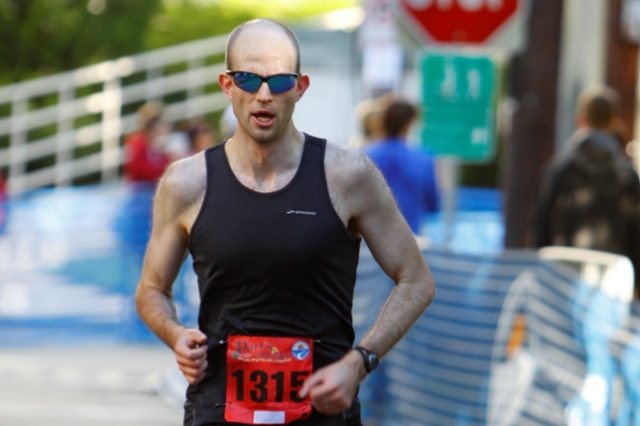
In spite of a tough season, Northwood’s girls have a lot to celebrate. Even with two top runners missing time because of injuries, one the entire season, they’re on their way to the state championship for the first time in almost 30 years.
Lest that sound like a long futility streak, know that from 1987 to 2004, the school itself was closed and the building used as a haven for other school’s students during renovations. Prior to that, the team scored state championships in 1975, 1977 and 1978.
[button-red url=”http://www.mpssaa.org/cross-country-state-qualifiers-head-to-hereford-saturday/” target=”_self” position=”left”] See who’s going to states [/button-red]But none of the nine runners who started this season healthy knew they would be headed to Hereford. After every practice, they talked about going to states, but, Gabriella Armanda said, even though it was “definitely a goal we had throughout the entire season, I didn’t think we’d make it.”
But with their fifth place finish in the 3A West Region Championships last week, they stamped their ticket.= for Hereford High School in Parkton Saturday. Races start at 10 a.m. with the 4A girls.
Their outstanding performance at Watkins Mill was turned out to be indicative of the team’s ability to rise to challenges and exceed even their own expectations of this season.
Despite (or, perhaps, because of) the difficulty of the course, three of the five scoring runners had season or career best times. When asked about their performance, they said they just knew they had to come together.
“All of our times improved, regionals was supposed to be a harder course, and all of us ran faster, just because everyone was trying to make it to states,” said sophomore Manpreet Dajal.
Their training this year has consisted of going out and finding out the biggest hill around and pounding hill workouts along with track workouts. It’s made a difference.
“Now, it’s to the point where we, like can’t run flats,” said sophomore Medalia Adhanon. Hill work is a hallmark of cross country running, but is especially necessary for the state championship course at Hereford. The infamous course, containing two passes through a punishing ravine referred to as “The Dip” is the a real life horror store with which upperclassmen torture freshman.
The Northwood girls have raced the course already and have decided that “it’s fine.” It may be hard, but at least they know what to expect. That attitude gives them a decided edge going into this weekend’s meet. They have the confidence that they are masters of the incline, and that they’ve met every setback this season has brought head on. On and off the trails, they have a strong bond as teammates, which continues to push them to make the right choices.
Other than coach Michael Sauter‘s commitment to grueling hill work, there has been no magic formula that got the girls pushing it harder and running better. Run a lot of hills, race harder the more it counts, repeat. Throughout September and early October, the team had five meets over 15 days, all of them on hilly courses, which prepared them for the challenge of Watkins Mill and has them ready for the infamous Dip. The extra racing gave the non-injured players they advantage of getting to tour some of the regions toughest inclines.
Junior Brody Harkness adds that learning how to manage speed on hills improves their racing “now we can take advantage, you try to push yourself harder.” There doesn’t seem to be much that the Northwood girls cross country team is afraid of, but hills are the least of their fears. They do hills.
Junior Alexis Dune has been the fastest Northwood runner during her entire tenure there, and owns her team’s all-time fastest time on the state meet course. Of Hereford and The Dip, Dune says simply “It’s a good course, it works your legs.”
That may be a slight understatement. Dune has battled hamstring injuries this season. She shrugs it off, attributing it to the transition from track to trails. When she mentions it, she calls it a “minor injury,” saying, “well, I didn’t break anything.”
Her teammates are quick to chime in to say that she’s downplaying what she’s come back from. She thinks if she can control her breathing going up the hills then she’ll be fine. Senior captain Laura Goldman is excited, even though it’s a hard course, and not just because she know she won’t have to run it again after Saturday.
The team has a knack for approaching challenges head on, in a matter of fact way. They credit their bonds as teammates outside of competition for helping them get through the season. The tougher the circumstances, the more difficult the course, the stiffer the odds, the better the Northwood girls seem to fare. Going into states with their top runner healthy and a season worth of hill-conquering racing under their belts bodes well for this group.
The girls made t-shirts this year that pretty much sum up their attitude towards racing. They read: “It’s a hill….get over it.” They credit the challenges of the season – their early tough schedule and their injuries, for bringing them together as a team and creating the obvious strong rapport that helps drive their performance.
The girls team aren’t the only ones having outstanding seasons in cross country this year. Coming off a national championship at the Junior Olympics in the 3,000 meters this summer, junior Michael Abebe is having an outstanding season. Abebe has only been running cross country for two seasons, after playing tennis, and he will be one to watch at the state meet.
When asked who on the girl’s team would be the first to pass Abebe, the girls universally nominated Alexis Dune, but on any given day, the team seems to be able to do exactly what they put their minds to. Their performance in states will undoubtedly contain excitement, tenacity, and team spirit. And, of course, hills.

Tall, sinewy, spectacled and pretty darn fast, Jonathan Ferguson has a direct gaze, matter of fact delivery, and an impressive running resume, but he shrugs off the suggestion that he’s intense. A former Division I swimmer at the University of Maryland who transitioned to running after college, Jonathan may have a “take it easy” button, but he doesn’t seem to have located it yet.
As a swimmer, he focused on freestyle and butterfly, but he’d swim every event. His coaches liked him in distance but he pushed to take over the shorter races. As a runner, his favorite distance is the 5k. A marathon was an absolute no, never. Like most reasonable people, it seemed like too much.
“I guess I was just really intimidated to it and didn’t think my body could hold up to long distance training,” he said.
But then, back in 2011, a co-worker who wasn’t going to be able to run Marine Corps offered him her bib. Already running high mileage and competing frequently in shorter races, he decided to give it a shot. That was 2011, the last time he ran the Marine Corps Marathon. He finished in 3:00:17, and blames trying to do the math in his head on the fly for not breaking the three hour mark.
In 2012 he completed the Baltimore Marathon in, again, seconds over three hours. Then, last year, he was training for Marine Corps last year when a stress fracture sidelined him. Not having had to deal with an injury like that before, he was disappointed and anxious to return to training. After taking time off, getting back to his routine to the point when he finally felt strong and pain free was a major milestone. Coming into this year’s race, he feels more confident than ever, and is looking forward to the race.
“My training has been pretty much ideal I’m really pretty excited. I want to get out there and see what I can do,” he said.
Jonathan’s goal for this year’s Marine Corps Marathon is a 2:50 – hopefully putting him well under the three hour mark, with a cushion to qualify for Boston in 2016. Jonathan is shooting for Boston in 2016, and one of the reasons he wants a cushion is that he doesn’t want to run a marathon next year. He and his wife are expecting their first child in February, which will surely change his training. How will he train for the next one? He isn’t sure.
“I know have to be a little more flexible, I just don’t know I’ll to work it out yet,” he said.
He’ll probably figure out a way – when he was training for his first marathon as a graduate student in Pittsburgh while working full time and going to school full time, he found himself fitting in runs when all his other obligations had been met – frequently starting training runs as late as midnight.
A relatively low-tech runner in the era where you can link your sneakers, watch, and heart rate monitor to your phone, Jonathan runs with a watch that tells you the time of day. He doesn’t train with music or any other distraction, thinking it would make him slow down during training. He uses the combination of that and his own internal clock and exertion meter to pace himself.
His Marine Corps strategy is to hold back until he gets through five mile in Georgetown, and then, basically, go all out from there. Jonathan know the theory behind negative splits, but it doesn’t suit his racing personality. He says that he feels most comfortable when he’s aggressive from the beginning. He thinks this harkens back to his swimming days.
“I never wanted to end up feeling at the end of the race like I had too much left.” He said, though he doesn’t always feel like it’s the best strategy: “I’m not crazy about it, I try to hold a reasonable pace. I’ve gotten into some trouble in the past with the Pittsburgh Half Marathon. It was my first fairly big race and I went out way too fast and the second half was really painful.”
His training plan is pretty straightforward. There aren’t a lot of complex algorithms or speed work to distance ratios. He basically runs, a lot, in and around his Greenbelt neighborhood. He averages 65 miles per week, with a tempo run and four twenty-milers. His long runs often consist of repeat loops around his neighborhood.
Since completing his Master’s in Public Policy (on top of a law degree), Jonathan has returned to the D.C. Metro area, which he loves, but he does miss the competition and camaraderie of his old running club in Pittsburgh, the Pharaoh Hounds. Though he’s met up with some of the area running groups, he hasn’t yet found a local club that fits in with his commute and schedule.
After managing to train for a marathon while working and going to school full time, coming back from a difficult injury with a long recovery, and managing the demands of a rigorous training schedule with work, commute, and family, there’s no doubt that Jonathan Ferguson has the tenacity required to meet his goal for this year’s Marine Corps Marathon. After that? He really wants to do the Cherry Blossom Ten Miler in under an hour. He’ll be focusing on shorter races as he takes on his new challenge as “Dad.”

